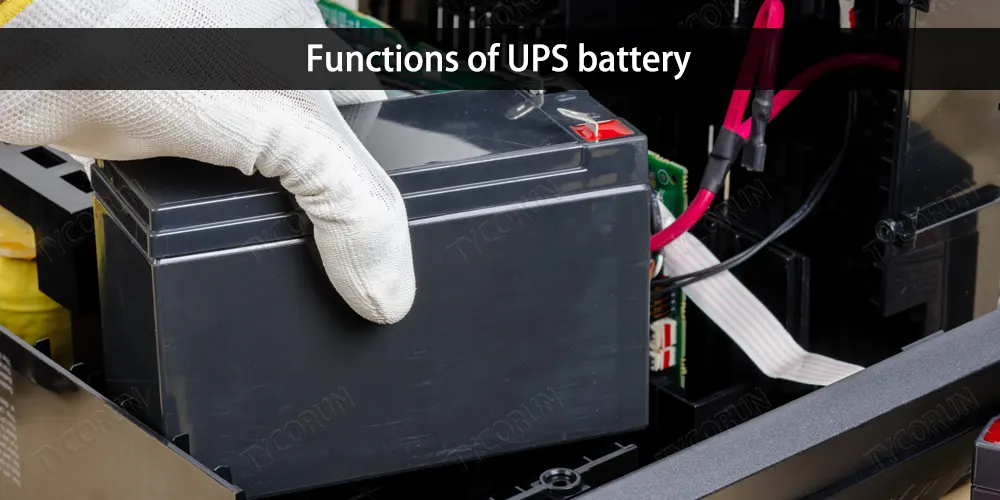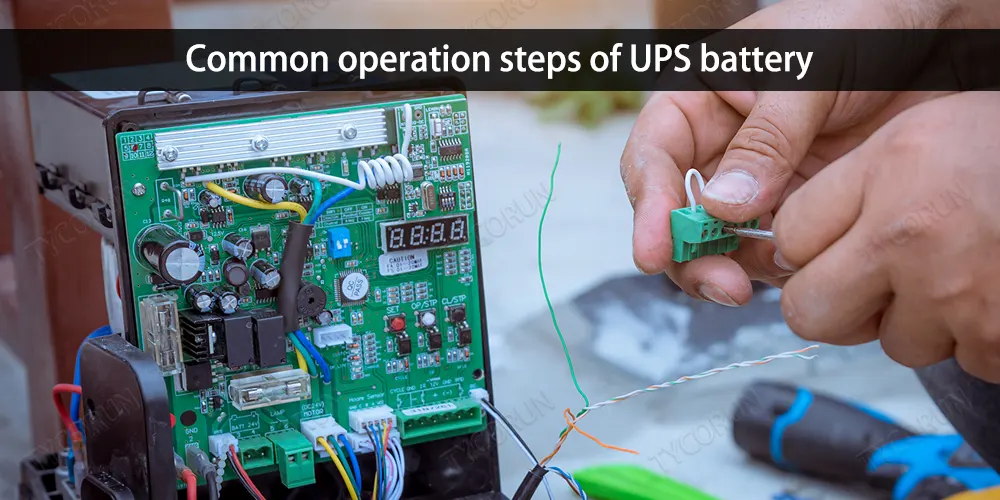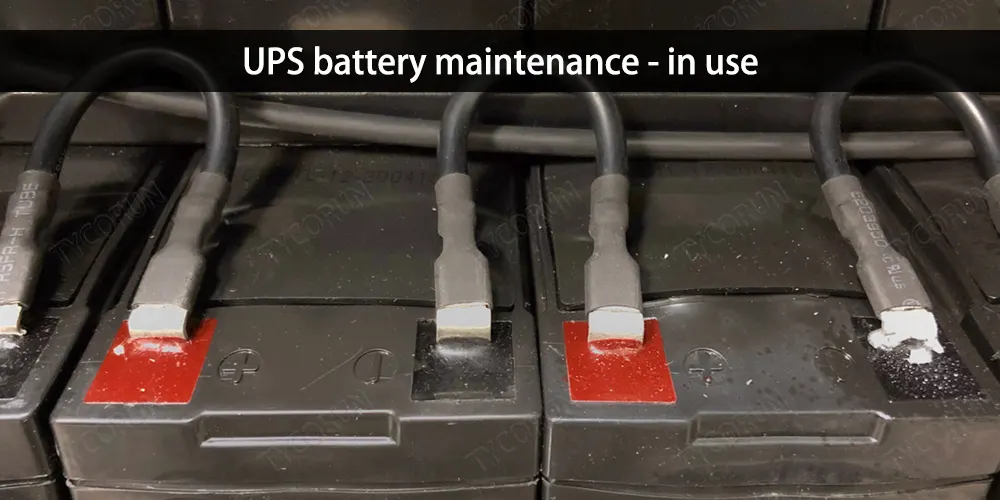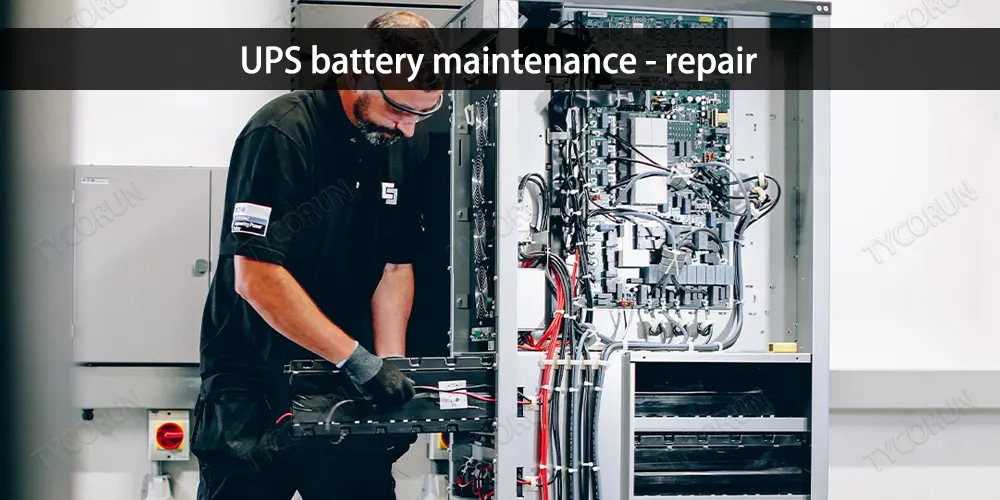Home » UPS battery » UPS battery maintenance, and correct use
UPS battery maintenance and correct use
UPS is an uninterruptible power supply containing energy storage devices. With the continuous development of battery technology and the promotion of electric energy, UPS battery is involved in various fields of daily life and work.
UPS battery has shown a rapid trend of development in recent years, however, UPS is not always durable in use, which makes UPS battery maintenance important. This article will provide you with suggestions for UPS battery maintenance and correct use methods.

What is UPS battery
UPS (uninterruptible power supply) battery is a constant voltage and constant frequency uninterruptible power supply with energy storage device and inverter as the main component.
Its main function is to provide uninterrupted power supply for a single computer, computer network system or other power electronic equipment. When the utility power input is normal, the UPS battery stabilizes the utility power and provides the load for use.
At this time, the UPS power supply is equivalent to an AC voltage stabilizer for utility power, and it also charges the battery inside the machine. When the power is interrupted, the UPS will immediately convert the power of the battery inside the machine to continue to supply 220V AC to the load through the method of inverter conversion, so as to maintain the normal operation of the load and protect the software and hardware of the load from damage.
UPS battery has been widely used in: mines, aerospace, industry, communications, national defense, hospitals, computer business terminals, network servers, network equipment, data storage equipment, emergency lighting systems, railways, shipping, transportation, power plants, substations, fire safety alarm system, wireless communication system, mobile communication, solar energy storage energy conversion equipment, and so on.

Functions of UPS battery
In addition to uninterrupted power supply, UPS battery also has 8 more functions.
1. Power failure protection
When the utility power grid momentarily fails, the UPS battery system immediately converts the DC power of the UPS battery into alternating current to continue supplying power to the load, avoiding the inconvenience and loss caused by the power cutoff.
2. Regulatory effect
The utility power voltage is easily affected by the distance and quality of the power transmission circuit. The voltage of users closer to the substation is higher, and the voltage of users farther away from the substation is lower.
If the voltage is too high or too low, it will affect the quality and service life of the user’s equipment, at serious situation, it will damage the equipment and cause heavy losses to the user. The use of UPS battery system can provide stable voltage power supply for user equipment, guarantee the normal operation of the equipment and prolong the service life.
3. Surge protection
Usually, the UPS power supply system has a cutting-edge discharge design to absorb the surge, so as to avoid affecting the service efficiency and life of the equipment due to the surge problem, and provide protection for the equipment.
4. High and low voltage protection
When the utility power voltage is unstable, the automatic voltage regulator (AVR) in the UPS keeps the voltage in a usable safe range to ensure the normal operation of the equipment. When the high and low voltage exceeds the usable range, the UPS power system will start the battery to supply power to ensure the continuous operation of the equipment.
5. Harmonic distortion protection
When the power is transmitted to the end of use through the transmission and distribution circuits and the voltage waveform is distorted, the fundamental current will change to generate harmonics. Harmonics will affect the use of equipment, and the UPS battery can provide stable and high-quality power for the equipment, effectively improving the operating efficiency and life of the equipment.
6. Frequency stabling
The frequency is the cycle of the utility power changes per second, for example, 50Hz means 50 cycles per second. When the utility power generator is running, it is subject to a sudden change in the power consumption of the user, which will cause the frequency of the converted power to be unstable. The power converted by the UPS power supply can provide a stable frequency to ensure the normal operation of the equipment.
7. Instant protection
There are voltage surges and sags or instantaneous voltage drops in utility power sometimes. Such problems will affect the accuracy of the equipment, and in severe cases, it will damage the precision equipment and cause losses to users. A UPS system can provide a stable voltage to protect the equipment.
8.Transverse mode and common mode noise suppressing
Transverse mode noise is generated between live and neutral wires, and common mode noise is generated between live, neutral and earth wires. Invisible power problems are hard to prevent, endangering the instruments and equipment all the time. The UPS battery escorts the instruments and data, ensures the normal operation of the equipment and prolongs the service life of the equipment.

Common operation steps of UPS battery
Before getting to the detailed tips for UPS battery maintenance, it is necessary to know how to operate the UPS battery.
| Start up |
|---|
| 1. Turn off the RESERVE switch. |
| 2. Turn off the RECTIFIER air switch: the AC indicator on the LCD panel is on. |
| 3. Turn off the BATTERY switch: the battery fault light on the LCD panel goes out. |
| 4. Press the inverter 0N switch on the LCD panel, and the inverter is turned on. |
| 5. Turn off the OUTPUT air switch: there is electric energy at the output end. |
| 6. Check whether the LCD display is correct: switch the LCD screen, check whether the content in the LCD is consistent with the actual situation, whether the fault light is on. |
| Shutdown |
|---|
| 1. Press the 0FF switch on the inverter. |
| 2. Cut off the BATTERY switch: so that the DC bus can be completely supplied by the rectifier. |
| 3. Cut off the air switch of the RECTIFILE: cut off the air switch of the rectifier, and the DC power is released after about 5 minutes (at least lower than 20VDC) |
| 4. Cut off the RESERVE air switch: the output of the output terminal will be interrupted immediately. |
| 5. Cut off the OUTPUT air switch. |
| Transfer load to UPS battery maintenance bypass |
|---|
| 1. Press the inverter OFF switch to turn off the inverter. |
| 2. Cut off the BATTERT switch: the DC bus power is completely supplied by the rectifier. |
| 3. Cut off the RECTIFLE air switch: cut off the rectifier air switch, and the DC power will be released after about 5 minutes (at least less than 20VDC). |
| 4. Turn off the UPS battery maintenance BYPASS air switch: the power supply will switch from the backup current circuit to the bypass circuit, and provide output power without interruption for the load to continue to use. |
| 5. Cut off the RESERVE air switch: release all the electric energy inside the UPS, and there is no electric energy inside the UPS to ensure the safety of UPS battery maintenance or repair personnel. |
| 6. Cut off the OUTPUT air switch: so as to ensure that the load power is not sent back to the inverter. |
| Transfer the load from the UPS battery maintenance bypass to the inverter |
|---|
| 1. Turn off the RESERVE air switch. |
| 2. Turn off the OUTPUT air switch: there is electric energy at the output end, and the load can be powered by the backup electric energy loop. |
| 3. Cut off the UPS battery maintenance BYPASS air switch: the power supply will continue to be supplied by the backup power circuit, and the AC output will not be interrupted. |
| 4. Turn off the RECTIFILE air switch. |
| 5. Press the 0N switch of the inverter to turn on the inverter. |
| 6. Turn off the BATTERY switch: when the rectifier is abnormal, the DC screen will immediately supply DC power to the inverter. |
Causes of UPS battery failure
In the process of using UPS lithium battery power suply, there will inevitably be failures. The following are some common reasons why it cannot be used normally.
- ● UPS battery transient overvoltage
Transient overvoltage refers to the pulse voltage whose peak voltage is as high as 20000V, but the duration is within one millionth of a second to one ten thousandth of a second. The main reason and possible damage are similar to high-voltage spikes, but there are differences in the solutions.
- ● UPS battery voltage sags
Voltage sag refers to a low-voltage state where the effective value of the utility power voltage is between 80% and 85% of the rated value, and the duration lasts for one to several cycles. This problem may be caused by the startup of large equipment, the startup of large motors, or the connection of large power transformers.
● UPS battery surge
Surge refers to the effective value of the output voltage is higher than 110% of the rated value, and lasts for one or several cycles. The surge is mainly due to the high voltage generated by the sudden unloading of the grid when the large electrical equipment connected to the grid is shut down.
- ● Continuous low voltage of UPS battery
Continuous low voltage means that the effective value of utility power voltage is lower than the rated value and lasts for a long time. The causes include: large equipment start-up and application, main power line switching, starting large motors, and line overload. If utility power has similar problems, it is recommended to ask the power department to measure the frequency, waveform and voltage of the power grid.

UPS battery maintenance – in use
Proper use of UPS battery can not only reduce the probability of UPS battery failure, but also prolong its service life reasonably. For the process of UPS battery maintenance, the following points should be noted:
- ● Environment: The location of the UPS power supply should avoid direct sunlight, the ambient temperature should be around 25°C, and leave enough ventilation space to keep it clean. Meanwhile, it is forbidden to connect inductive loads to the output port of the UPS battery.
- ● Lines: When using UPS power supply, must abide by the relevant regulations of the product manual of the UPS custom lithium battery manufacturers to ensure that the live wire, neutral wire, and earth wire connected as required, and the user is not allowed to change their mutual order at will.
- ● Operation panel: observe the display control operation panel of the UPS main unit on site, and confirm that all graphic display units on the LCD panel of the UPS power supply are in normal operation, and all operating parameters of the UPS are within the normal range without fault or alarm signs.
- ● Operation sequence: Strictly follow the correct start-up and shutdown sequence to avoid the UPS battery from not working properly due to large fluctuations in the voltage output when the load is suddenly added or unloaded.
- ● Load capacity: Observe the load capacity and backup time of the UPS power supply. If there is any change, check whether there is an increase or unknown fault in the load, and the current operation of the load. If it is overloaded, it will break down the inverter triode in the inverter state. For most UPS power supplies, controlling its load within the range of 30% to 60% of rated output power is the best working method.

- ● Output voltage: When the output voltage of the UPS power supply is found to increase abnormally, check whether the filter capacitor of the UPS power supply is intact.
- ● Switching: Should not turn off and on the UPS battery frequently. Generally, it is required to wait at least 6 seconds before turning on the UPS power supply after turning it off. There is no utility power output and no inverter output status. Otherwise, the UPS power supply may concur failure to start, that is, the UPS battery enters the state of neither utility power output nor inverter output.
- ● Temperature: Check for obvious signs of overheating.
- ● Regular UPS battery maintenance: Keep UPS battery maintenance regularly, remove the accumulated dust in the machine, and make sure the fan exhaust air filter is clear of any blockages. Measure the voltage of the battery pack, replace unqualified batteries, check the operation of the fan and detect and adjust the system parameters.
- ● Noise: Pay attention to whether there are suspicious changes in the audio noise, and pay special attention to the sound of the input and output isolation transformers of the UPS battery. When abnormal squeaks appear, there may be poor contact or poor insulation between turns. When there is a low-frequency “cymbal sound”, the transformer may have a problem of bias magnet.
The above inspection results should be recorded as far as possible to analyze whether there are any significant deviations from normal operation. In short, following the operating procedures for the UPS battery maintenance in use is an important guarantee for the continuous normal operation of UPS power supply.

UPS battery maintenance – repair
- ● Dust
In normal use, it doesn’t need much UPS battery maintenance, mainly includes dust removal and dust prevention. Especially in areas with dry climate, there are more ash particles in the air, and the fan inside the machine will deposit dust into it.
When the air is humid, it will cause the host control disorder, resulting in inaccurate alarms, and a large amount of dust will cause bad heat dissipation of the device. The UPS should be thoroughly cleaned once every three months. And also need to check whether the connectors and connectors are loose and not firmly in contact when the dust is removed.
- ● Battery
Although the UPS battery packs are currently using maintenance-free batteries, which does not require much UPS battery maintenance, the impact of external working conditions on the battery has not changed, and the impact of abnormal working conditions on the battery is still there, making UPS battery maintenance and repair very important, and the UPS battery maintenance and repair work is mainly in the battery part.
- ● Fault locating
When the UPS battery fails, the cause should be identified first to distinguish whether it’s the problem of the load or the UPS system, or whether it’s the main engine or the battery pack. Although the UPS host has the fault self-test function, which is very convenient for replacing parts, but to repair the exact fault point, still need to do a lot of analysis and detection work. In addition, if the battery test fails, the fault point displayed may be incorrect.
- ● Damage on UPS host
If the UPS host is punctured, the fuse breaks, or any part get burned, it is necessary to find out the cause and remove the fault before restarting, otherwise the same fault will occur in succession.
- ● Safety rules
Pay attention to safety when processing UPS battery maintenance. When handling power supplies, even a small error in operation can cause serious injury. Therefore, when handling UPS battery maintenance, safety rules should be followed, including following the equipment manufacturer’s recommendations, paying attention to facility specific details and standard safety guidelines.























